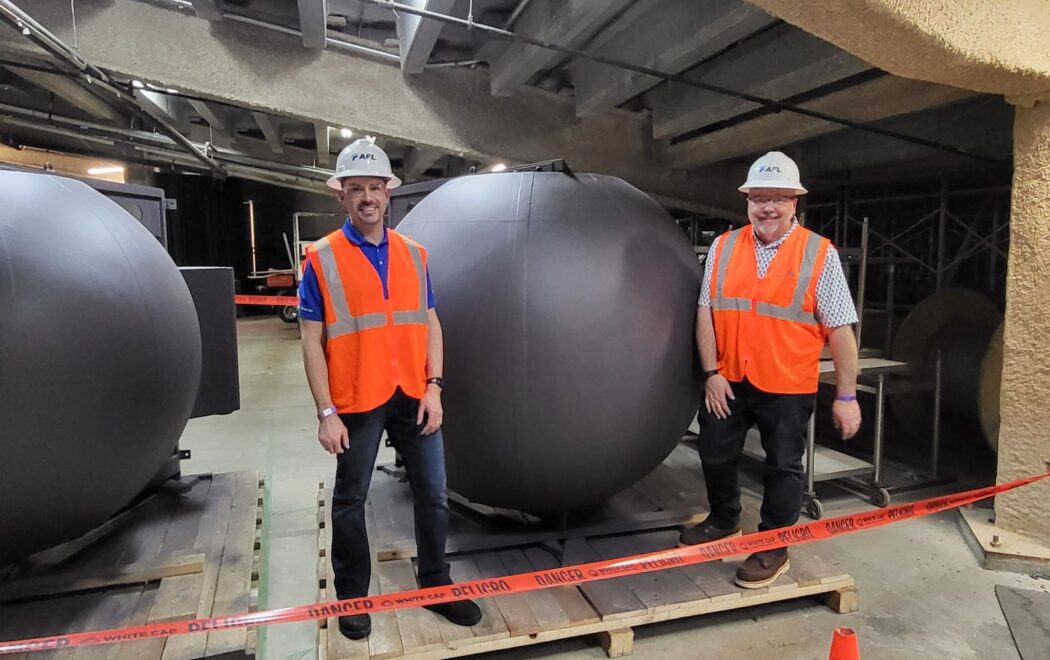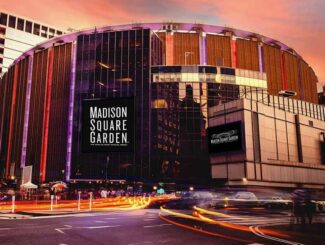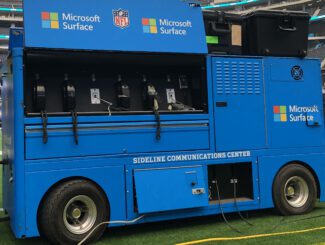
Take a bow, MatSing lens antennas! Why? because your inherent technology was no doubt the MVP of the cellular activity at Super Bowl 59 in New Orleans, where Verizon and AT&T saw a combined 67.1 terabytes of data used Sunday in and around the Caesars Superdome.
As part of a full rip-and-replace distributed antenna system (DAS) build inside the venue this past year, there was something close to 300 MatSing antennas of various shapes and sizes put into the Superdome. AT&T, as the neutral-host DAS provider for the building, said it installed 30 of the “big” MatSing ball antennas in the Superdome ceiling and another 255 of the smaller-sized MatSing antennas underneath the overhangs, in the concourses and other back-of-house areas.
Verizon, which used the AT&T shared DAS infrastructure, also installed some more MatSings (as well as some antennas from Samsung) for its own use. When it comes to the exact count of MatSing gear installed it’s mostly a guess since some carriers are purposely vague as to which antennas they paid for and which are shared, but — does it matter? The real takeaway from all the new-gear stories is that the MatSing antennas — which we’ve written about extensively — were the perfect choice for an old venue like the Superdome, with lots of ability to hang stuff in the rafters given the construction characteristics of the roof. Because of the way they are built the MatSings are also reportedly much easier to tune and deploy — another bonus when you are retrofitting.
AT&T sets its own Super Bowl cellular record
But enough about the supporting cast, what about the results? Since AT&T built the shared stadium DAS (which it hasn’t done in a Super Bowl since forever) it seems right to give them first props, especially since the 29 TB of data used by its customers “in and around the stadium” (remember that term) was the most-ever for AT&T at the NFL’s annual Big Game. AT&T, which did not report cellular data totals from last year, saw 21 TB of data used by its customers at Super Bowl 57 in Glendale, Ariz., at State Farm Stadium in 2023, its previous high-data mark.

Verizon, meanwhile, said it saw 38.1 TB of data used by its customers “in and around the stadium” for Super Bowl 59 in New Orleans, where the company had built out one of the more extensive game-day supplemental networks we’ve seen. If the in-and-around number wasn’t the highest-ever for Verizon (it reached that mark last year in Las Vegas, where Verizon customers used 52.34 TB of data at Super Bowl 58), we have a couple other statistics that show just how well Verizon’s networks were used in the Big Easy.
The first one is the 93.5 TB of data Verizon said it saw customers use “across New Orleans” on Super Bowl Sunday. If you’ve ever been to the Superdome you know it sits basically right at the edge of the town’s famed French Quarter, and a whole host of walk-to areas that Verizon said it absolutely blanketed with coverage to make sure that Super Bowl fans were connected with wireless wherever they went. I know it’s a bit of a commercial but I love this video that Verizon produced, which wins the STR medal for “most geeky antenna placements shown in a vendor video.”
To be honest, the “in and around the stadium” caveat applied to all carriers’ Super Bowl stats is what keeps us from trying to draw any straight lines like we do with our annual Super Bowl Wi-Fi data-use coverage, since only numbers from inside the actual stadium count in that count. (One year an ambitious wireless carrier that no longer exists gave us “in and around” cellular Super Bowl numbers that had to include pretty much anyone with a phone in the greater tri-state area surrounding the stadium, so… we’ve learned to not to worry too much about those totals since the geographic boundaries are so variable.)
Verizon keeps up its per-device data leadership
The measurement we have been tracking more closely over the past few years, the per-device data used, is actually more interesting to us since it’s a clearer picture of how actual users are using the network. Last year at Allegiant Stadium the users of the fan-facing Wi-Fi hit an average of 788 megabytes per connected device, a record for Super Bowl Wi-Fi in our unofficial totals.
While the cellular carriers generally don’t share the number of exact users seen on their networks at the Super Bowl, for the past three years Verizon has included a number in its statistics that tells you the percentage of fans in the stadium who used Verizon’s network. This year that number was “approximately 53 percent of the 65,719 attendees,” so to start our math fun we say 34,381 fans at the game were Verizon customers. (Please feel free to check and correct our numbers if you find our arithmetic skilz wanting.)
When you take that number and divide it into 38.1 TB of data used, you get a figure of approximately 1.09 GB of data used per connected Verizon customer, a big jump over our record Wi-Fi per-device numbers. And at Super Bowls 58 and 57 those numbers for Verizon were 1.68 GB and 1.17 GB respectively, which shows to us that Big Red does a great game-day job of providing bandwidth to its big-game customers.
Some more quick results from Verizon: At the Superdome Sunday night, Verizon said it saw a peak download speed of 4,161 Mbps and a peak upload speed of 1,067 Mbps, and a median download speed of 1,775 Mbps and median upload speed of 159 Mbps. Look, if you’re going to tell your customers to use your network instead of Wi-Fi, it’s not such a bad thing if you have the stats to back it up.
Stay tuned for our coverage of the Super Bowl Wi-Fi statistics (provided by our friends at Extreme Networks), which take a little more time to bake.
If and when we hear from T-Mobile (we have a request out) we will revise this post to add their Super Bowl data totals in.






